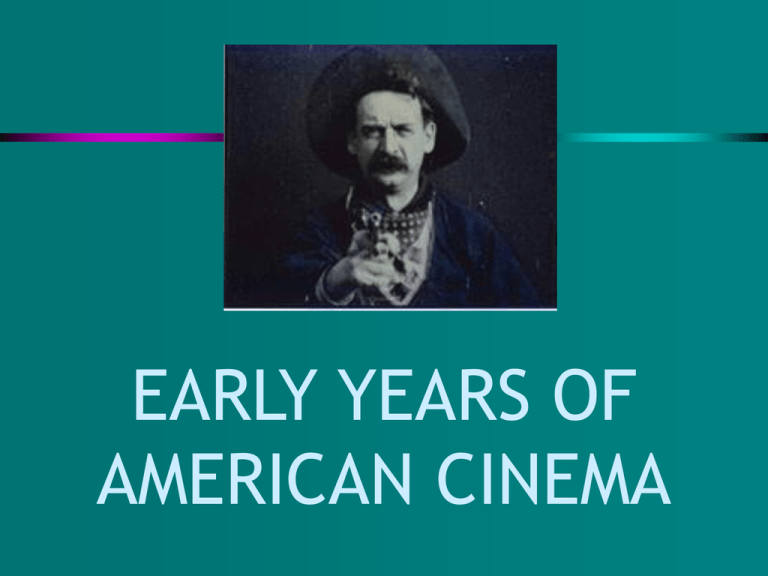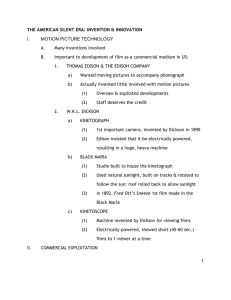Black Maria
advertisement

EARLY YEARS OF AMERICAN CINEMA The Hollywood film has 3 characteristics: MASS MEDIUM COMMERCIAL NARRATIVE art form Could have developed as: Scientific instrument Medium of home entertainment 3 ESSENTIAL CONDITIONS Growth of large urban areas Increase in leisure time Development of the necessary technology THE URBAN POPULATION BASE Urban areas, esp. in northeast & midwest, grew dramatically at the turn of the century Provided concentrated masses of people necessary for film to be a commercial medium CAUSES OF THE GROWTH OF URBAN AREAS Immigration from abroad Mostly from southern & eastern Europe Fewer farmers, sought industrial jobs in the cities Tended to live in cohesive, discrete communities Mostly very poor, few spoke English 1st movie audiences, key figures in the industry Migration to the cities from rural areas Americans left farms, sought work in the cities 1870 - 25% of Americans lived in urban areas 1910 - 45% lived in urban areas 1920 - over 50% lived in urban areas Trend continued until WW II, then reversed (rise of TV) INCREASE Shorter IN LEISURE TIME workweeks came about because of: Automation State & local regulations Growth of unions Shrinking 1900 workweek: - average workweek was 66 hours 1910 - 56 hours 1920 - 41 hours Movies had advantages over other entertainment Cheap (5-10¢) Suitable for the entire family No English was required (silent films) THOMAS EDISON & THE EDISON COMPANY Wanted moving pictures to accompany his phonograph Invented almost nothing involved with motion pictures W.K.L. DICKSON & KINETOGRAPH 1890: 1st important motion picture camera Electrically powered, resulting in a huge, heavy machine BLACK MARIA Studio built to house the kinetograph Because it used natural sunlight, built on railroad tracks, rotated to follow the sun; had a roof which could be rolled back to allow sunlight In 1892, Fred Ott's Sneeze 1st kinetograph film made in the Black Maria Black Maria Fred Ott’s Sneeze KINETOSCOPE Invented by Dickson for viewing films made Electrically-powered, showed short (45-60 sec.) films to only 1 viewer at a time KINETOSCOPE 1894, PARLORS Edison contracted with Raff & Gammon to open parlors filled with kinetoscopes in NYC Charged 25c for admission Made $ 1st year, then lost $ due to cost of maintenance The Kinetoscope Dance THOMAS 1895, ARMAT & THE VITASCOPE Armat developed primitive film projector called the Vitascope; many people could view a film at 1 time Edison bought the invention & manufactured it Premiered in NY at Koster & Bial's Music Hall, 1896 Then distributed throughout the US The Vitascope Vitascope advertisement EDISON'S COMPETITORS Relatively cheap & easy to make equipment & films Most important was the BIOGRAPH company Established in 1896 by Dickson, who had left the Edison Co. Well-financed (Rockefeller $) Dropped electrically-powered camera for a hand-cranked camera Early film industry truly competitive, many small companies sharing market fairly equally THE NICKELODEON ERA Exhibition of films has gone through 3 broad stages: NICKELODEON ERA relatively short, but established the base audience for motion pictures PICTURE PALACE ERA symbolizes exhibition during Hollywood's “Golden Age” SHOPPING MALL MULTIPLEX typifies film exhibition today THE NICKELODEON ERA (1905-1915) 1905, movie boom began, popular activity esp. in urban ghettos Nickelodeon Theater opened in Pittsburgh Soon, all small movie theaters known as “nickelodeons” By 1910, 10,000 in major cities throughout the US Audience almost exclusively working class DESCRIPTION Admission price 10c, rarely actually 5c Small, simple, often converted storefronts, in working class neighborhoods Accommodated about 50-100 people Films accompanied by piano player, interpreter in ethnic neighborhoods PROGRAM About 1 hr. long, included usually 3 short films (10 min. each) Films, also included vaudeville acts Films mostly French slapstick comedies Program changed 2-3 times per week, stimulating demand for films & growth of production companies PATRONS Called “Democracy's Theater” Ticket prices of available entertainment: Opera & Theater Good Vaudeville Bad Vaudeville Nickelodeon Average $2.00 .50 .15 .10 Upper class Middle class Middle class Working class income of a working-class family was $12-15 per week, with about $1.25 available for entertainment The Nickelodeon CHANGE FROM WORKING CLASS TO MIDDLE CLASS 1912, change in audiences (process had begun as early as 1905) Theater owners sought prestige, more $; higherclass audience Offered special rates to women & children In military towns, favored officers & banned enlisted men Tried to lose reputations as “ethnic theaters” Avoided films heavily slanted toward particular ethnic groups Avoided ethnic vaudeville acts Eliminated songs in foreign languages Built theaters in middle-class neighborhoods Vaudeville houses & legitimate theaters began showing movies MPPC's efforts to “Americanize” industry helped transition Most 1915, American directors white & middle-class D.W. Griffith's Birth of a Nation 3 hours long, more like play or novel, less like vaudeville $2 ticket price Attracted a large white, middle-class audience Exhibitors began to seek more expensive, longer films, & producers met this demand End of MPPC, which made 1-reelers exclusively, helped end the nickelodeon; independents made feature-length films The Birth of a Nation Nickelodeon era short, but had important impact on American film industry Created an audience & demand for movies; working class never abandoned the movies Stimulated growth of movies as both industry & cultural phenomenon






